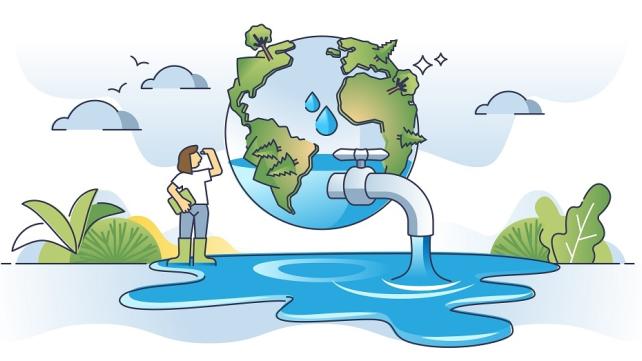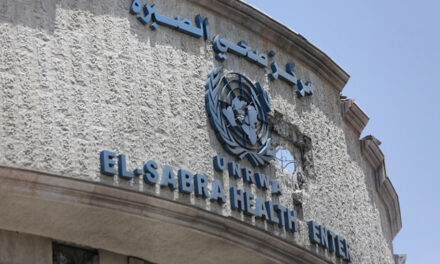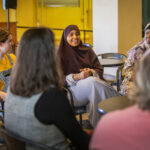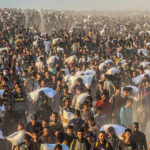With our growing population and scarce freshwater resources, it is becoming more and more important to conserve the water we use. According to the National Geographic Society, 3% of the world’s water is freshwater.1 And of that freshwater that comes from rivers, streams, and lakes, only 1.2% of it is drinkable. The rest of that freshwater is frozen in glaciers, ice caps, and permafrost. In light of this, around 1.2 billion people face water scarcity, and 500 million more are beginning to approach the same fate, according to the United Nations.2
Moreover, the way people use water is not sustainable, especially in areas where it is seemingly plentiful. And when the water is wasted, that makes the resource scarcer. What better than to teach our own children, the future, environmental-friendly practices of water usage to sustain their lives?
Our beloved Prophet, peace and blessings be upon him, practiced water conservation in his life. For example, he would use just two-thirds of a liter of water to perform wudu or ablution. And he would use only around 3 liters of water to bathe himself. Surely, living in the desert had made him highly aware of conserving water. As a sunnah, or Prophet’s practice, we should follow his example as well, as he advised:
“Do not waste even if performing ablution on the bank of a fast-flowing large river.”
(Al Tirmidhi)
Therefore, even when there is an abundance of water, we still cannot waste the water we use. We must conserve no matter how much water we are blessed with. Subhan Allah, God is Exalted.
Lessons on Conservation
To begin now, here are some ways you can teach your child to save more daily use of water in each domain of their lives. There are many places in our homes where we use water daily.
In the bathroom, children can:
- Turn the tap on with a low flow while washing their hands.
- Turn the tap off while brushing their teeth.
- Take shorter showers or turn the shower off while applying soap and shampoo. They can turn it on again to rinse off.
- Avoid multiple flushes of the toilet unnecessarily.
In the kitchen, children can:
- Fill a bowl of water and wash their fruits and vegetables in it, avoiding running water to do so.
- Use excess water from their cups to water plants.
- Use the automatic dishwasher for only full loads.
- If washing by hand, apply soap to all the dirty dishes first, and then rinse them off in one go.
- Have a jug of water in the fridge to drink from when thirsty.
- Fill half a glass of water first and finish it. They may refill it if they want more.
In other areas of the home, children can learn to:
- Only turn on the washing machine for large loads; keep filling it throughout the day until full, then turn it on.
- Be aware of harvesting rainwater by having a collection system in place outside of your home, and how to use it for watering the garden or washing the car.
- Fix simple plumbing systems when leaks or clogs happen, so that they can do it when they are older.
Dealing with a Water Crisis
If there is a water crisis in the area that you live in, there are ways we can involve our children to prepare for it.
1. Have your child suggest ways on how they conserve water at home. Involving them in the decision-making process and having them implement their suggestions will inspire them to make more of an effort to save water.
2. You can have children be aware of the amount of water your family consumes every month. This can be demonstrated by showing them the water bill and what practices increase the bill amount. This way, they can be more aware of how much water they are using and do their best to decrease its usage. Acknowledge their efforts when they do so.
3. Any water that gets saved up, say in a water bottle, drinking glass, and so on, can be saved in a large container they can keep account of. This way, they can see small actions such as these can go a long way in conserving water and be used later for other activities such as watering the garden or washing the car. This skill can be transferred to harvesting rainwater in the backyard. Show them how it works and have them use it.
4. Planting trees and having forested areas brings more rain. Children can observe that trees are part of the water cycle, providing more rain, because of the process of transpiration. When they go for a tree-planting excursion, they can be made aware of the importance of trees in making rain happen, therefore averting or lessening the frequency of water crises in their area.
Climate change affects us more and more on a daily basis, with increased floods, desertification, and wildfires. We can see these changes before our eyes all over the globe. Families can become a part of practicing more sustainable ways of living to preserve their future livelihoods, inshaAllah, God-willing. Conserving water and understanding how water crises affect people around the world are the first step. As they grow older, perhaps they can be one of the people who help resolve water scarcity and crises in some parts of the world, inshaAllah, God-willing. It all starts with you, the parent.
End Notes
1 Earth’s Fresh Water | National Geographic
2 Water scarcity | International Decade for Action ‘Water for Life’ 2005-2015
By Sumayya Khan
Sumayya Khan is a homeschooling mother of two and a teacher. She has worked with several Islamic schools and organizations in the last 10 years. She is currently tutoring, and studying the Qur’an through Al-Huda Institute. In her free time, she loves to spend time with her family and friends, play sports, enjoy nature, and read books. She currently resides with her family in Toronto, Canada.














